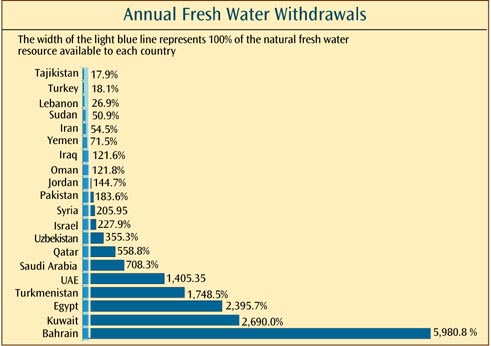
Source: United Nations Development Program, “Human Development Report 2000”, Table 21,
http://hdr.undp.org/reports/global/2000/en/
“...Altogether, (groundwater) aquifers store 97% of the planet’s freshwater.” 8
“…Nearly one third of all humanity relies almost exclusively on groundwater.” 9
“...average annual rainfall in the Middle East is less than 9.8 inches/year, (except on the Mediterranean coast and upland areas of Lebanon, Syria and Iraq). Only Turkey and Iran have a relative water surplus.” 5
“...a region where water ranks above oil as the most precious resource...” 6
“...per capita water availability in the Middle East has become the worst in the world...1/3 of Asian and 15% of African levels...” 6
“Water tables are falling from the over-pumping of groundwater in the breadbaskets and rice bowls of central and northern China, northwest India, parts of Pakistan, much of the United States, North Africa, the Middle East, and the Arabian Peninsula. Farmers in these regions are pumping groundwater faster than nature is replenishing it.” 5
|
“At the current rate of extraction, Saudi Arabia is running toward total depletion in the next fifty years.” 2
“The Aral Sea basin shared by Afghanistan, Iran and five countries of the former Soviet Union was once the world’s fourth largest lake. Excessive river diversions have caused it to lose half its area and three-fourths of its volume, while its surrounding wetlands have shrunk by 85 %...almost all fish and waterfowl species have been decimated and the fisheries have collapsed.” 2
Lowering the level of a lake or river destroys its natural edge — the most important area of an aquatic ecosystem.
“...Agriculture consumes between 75% and 90% of water in the Middle East...” 6
“The industries requiring the most water... are petroleum refining, food processing, metals, chemical processing, and pulp and paper... the industrial use of water... creates toxic and hazardous pollutants that renders waste water unfit for subsequent human consumption or use in the agricultural sector; these conditions can also permanently pollute aquifers. The expansion of industry to the developing world, in addition to local human contamination of fresh water supplies, is making it more difficult to maintain water quality” 7
“90% of the developing world’s waste water is still discharged untreated into local rivers and streams.” 2
“…Groundwater pollution is essentially permanent. Water recycles extremely slowly underground, too slowly to flush out or dilute toxic chemicals. Water that enters an aquifer remains there for an average of 1,400 years, compared to only 16 days for rivers.” 9
“In the late 1990’s, India’s central pollution control board found that groundwater was unfit for drinking in all 22 major industrial zones it surveyed…” 3
“More than five million people, most of them children, die every year from illnesses caused by drinking poor quality water.“ 2
“Climate warming is also likely to have a disastrous long-term ecological effect...” 6
“Vulnerability to attack, dependency on foreign sources of energy, prohibitively high costs... make desalinization... a strategic liability.” 6
“...desalination efforts... high energy and large costs... limited to cash and energy rich oil-exporting countries such as Oman and Saudi Arabia.” 6
“Suez Lyonnaise des Eaux [built the Suez Canal; 1999 profits of $1.5 bil on sales of $32 bil.] and Vivendi SA are referred to as the General Motors and Ford company of the water world. Between them, they own, or have controlling interest in, water companies in 120 countries on five continents and distribute water to almost 100 million people in the world.” 2
|
|
Sources:
1. United Nations
Development Program, “Human Development Report 2000,”
Table 21; http://hdr.undp.org/reports/global/2000/en/
2. Maude
Barlow,“Blue Gold,” (2001); http://www.canadians.org
3.
Paval Sambat, “Trouble Beneath our Feet: A
Global Sampler of Groundwater Pollution,” World Watch (2000), http://www.worldwatch.org
4. Sandra Postell,
“Drought Foreshadows Larger Water Threat,” World Watch (1999), http://www.worldwatch.org
5. Natasha Beschorner,
“Water and Instability in the Middle East,” (1992), quoted in “The Threat of Intentional Oil Spills to Desalination Plants in the Middle East: A U.S. Security Threat,” 1998, James E. Lovell, Maj, USAF, http://research.maxwell.af.mil/papers/student/ay1998/acsc/98-171.pdf
6 . Ilan Berman and
Paul Michael Wihbey, “The New Water Politics of the
Middle East,” (Strategic Review, Summer 1999),
http://www.israeleconomy.org/strategic/water.htm
7. Kent Hughes Butts,
“The Strategic Importance of Water,” Parameters (1997), http://carlisle-www.army.mil/usawc/Parameters/97spring/butts.htm
8. Paval Sambat,
“Deep Trouble; The Hidden Threat of Ground Water
Pollution,” World Watch (2000)
9.“The Hidden Fresh Water Crises,”
World Watch (2000).
|
Please click here to view our selection of water supply related links.
|